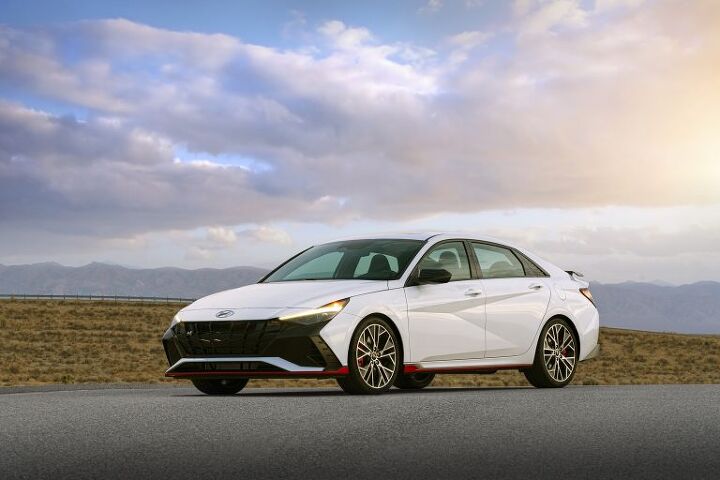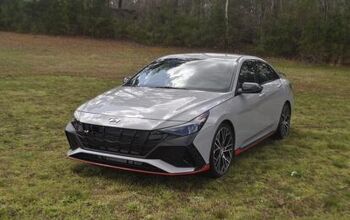2022 Hyundai Elantra N: The Full Hotness

Hyundai’s performance offensive continues with the 2022 Hyundai Elantra N.
Which, yes, is available with a manual transmission.
Hyundai already offers a spiced-up Elantra N-Line (which also allows the driver to shift for his or herself), but now there’s a model for those who pick the spiciest sauce option at the chicken-wing joint.
A 2.0-liter turbo four-cylinder with direct injection is at the heart of it all, making up to 276 horsepower and 289 lb-ft of torque. Peak horsepower hits around 5,500 RPM, while peak torque is available as low as 2,100 RPM.
Available transmissions are a six-speed manual and an eight-speed wet, dual-clutch automatic transmission. The auto offers the “N Grin Shift” feature, which temporarily increases boost pressure, giving the car 286 horsepower for a few seconds. The automatic also gets “N Power Shift” (maximizes torque for upshifts) and “N Track Sense Shift” (automatically finds the correct gear and shift timing when the car senses it’s being driven on track) features.
Rev-matching is available with both transmissions and can be turned on/off via a steering-wheel button on the manual.
Hyundai has given the car an electronically-controlled limited-slip differential to help reduce understeer, launch control (for both transmissions), and a variable-exhaust valve system.
The car has 14.2-inch brake rotors and Hyundai has set things up to make sure they’re able to cool off easily. Purists will note that the parking brake is mechanical. handbrake turns for all?
Hyundai claims to have saved a few pounds by integrating the driveshaft and wheel hub and bearing. Another weight reduction is apparently achieved by integrating the air intake and air filter. Hyundai has also adjusted the shape of the powertrain mount in a bid to improve handling. The N has rack-mounted electronic power steering.
Insulation has been added to the stiffened electronically-controlled/dampened suspension to reduce noise, vibration, and harshness. A virtual engine-sound system is available. The car rides on Michelin Pilot Sport tires (245 width) and 19-inch wheels.
As with the Kona N, there’s an N-specific infotainment screen that gives the driver all sorts of performance info, and drive modes can adjust things like steering feel.
The car gets a body kit that includes a unique front fascia, lip spoiler, rear-wing spoiler, rear diffuser, and dual exhaust.
Inside, you’ll get a lot of N badges, paddle shifters for the automatic, sport seats that are lower and thinner, and steering-wheel buttons for the N modes (including Sport, Sport +, and N mode) and for the N Grin Shift (for automatics).
Safety and driver’s aids aren’t forgotten, as the Elantra N includes forward collision-avoidance assist, lane-keeping assist, lane-following assist, driver-attention warning, high-beam assist, blind-spot collision-avoidance assist, rear cross-traffic collision-avoidance alert, and safe-exit warning.
Hyundai’s BlueLink connected-car application is available.
Feature-wise, everything is standard, meaning your only choice is transmission and color. Those colors include Performance Blue and Cyber Gray. Those standard features include LED lighting, wireless device charging, heated front seats, Bose audio, navigation, Bluetooth, satellite radio, 10.25-inch infotainment screen, Android Auto, Apple CarPlay, dual USB ports, dual-zone climate control, digital key, keyless entry and starting, and hand-free trunk release.
Pricing hasn’t been released, but Hyundai says it will undercut the Honda Civic Type R, which it sees as a rival. Speaking of rivals, Hyundai has also targeted the Volkswagen GTI and GLI, and the redesigned Subaru WRX, even though that car is all-wheel drive and the Elantra N is front-drive.
As always, we can’t fully judge a car until we drive it, but based on the paper specs, we’ll happily choose the full-spice option.
[Images: Hyundai]

Tim Healey grew up around the auto-parts business and has always had a love for cars — his parents joke his first word was “‘Vette”. Despite this, he wanted to pursue a career in sports writing but he ended up falling semi-accidentally into the automotive-journalism industry, first at Consumer Guide Automotive and later at Web2Carz.com. He also worked as an industry analyst at Mintel Group and freelanced for About.com, CarFax, Vehix.com, High Gear Media, Torque News, FutureCar.com, Cars.com, among others, and of course Vertical Scope sites such as AutoGuide.com, Off-Road.com, and HybridCars.com. He’s an urbanite and as such, doesn’t need a daily driver, but if he had one, it would be compact, sporty, and have a manual transmission.
More by Tim Healey
Latest Car Reviews
Read moreLatest Product Reviews
Read moreRecent Comments
- W Conrad I'm not afraid of them, but they aren't needed for everyone or everywhere. Long haul and highway driving sure, but in the city, nope.
- Jalop1991 In a manner similar to PHEV being the correct answer, I declare RPVs to be the correct answer here.We're doing it with certain aircraft; why not with cars on the ground, using hardware and tools like Telsa's "FSD" or GM's "SuperCruise" as the base?Take the local Uber driver out of the car, and put him in a professional centralized environment from where he drives me around. The system and the individual car can have awareness as well as gates, but he's responsible for the driving.Put the tech into my car, and let me buy it as needed. I need someone else to drive me home; hit the button and voila, I've hired a driver for the moment. I don't want to drive 11 hours to my vacation spot; hire the remote pilot for that. When I get there, I have my car and he's still at his normal location, piloting cars for other people.The system would allow for driver rest period, like what's required for truckers, so I might end up with multiple people driving me to the coast. I don't care. And they don't have to be physically with me, therefore they can be way cheaper.Charge taxi-type per-mile rates. For long drives, offer per-trip rates. Offer subscriptions, including miles/hours. Whatever.(And for grins, dress the remote pilots all as Johnnie.)Start this out with big rigs. Take the trucker away from the long haul driving, and let him be there for emergencies and the short haul parts of the trip.And in a manner similar to PHEVs being discredited, I fully expect to be razzed for this brilliant idea (not unlike how Alan Kay wasn't recognized until many many years later for his Dynabook vision).
- B-BodyBuick84 Not afraid of AV's as I highly doubt they will ever be %100 viable for our roads. Stop-and-go downtown city or rush hour highway traffic? I can see that, but otherwise there's simply too many variables. Bad weather conditions, faded road lines or markings, reflective surfaces with glare, etc. There's also the issue of cultural norms. About a decade ago there was actually an online test called 'The Morality Machine' one could do online where you were in control of an AV and choose what action to take when a crash was inevitable. I think something like 2.5 million people across the world participated? For example, do you hit and most likely kill the elderly couple strolling across the crosswalk or crash the vehicle into a cement barrier and almost certainly cause the death of the vehicle occupants? What if it's a parent and child? In N. America 98% of people choose to hit the elderly couple and save themselves while in Asia, the exact opposite happened where 98% choose to hit the parent and child. Why? Cultural differences. Asia puts a lot of emphasis on respecting their elderly while N. America has a culture of 'save/ protect the children'. Are these AV's going to respect that culture? Is a VW Jetta or Buick Envision AV going to have different programming depending on whether it's sold in Canada or Taiwan? how's that going to effect legislation and legal battles when a crash inevitibly does happen? These are the true barriers to mass AV adoption, and in the 10 years since that test came out, there has been zero answers or progress on this matter. So no, I'm not afraid of AV's simply because with the exception of a few specific situations, most avenues are going to prove to be a dead-end for automakers.
- Mike Bradley Autonomous cars were developed in Silicon Valley. For new products there, the standard business plan is to put a barely-functioning product on the market right away and wait for the early-adopter customers to find the flaws. That's exactly what's happened. Detroit's plan is pretty much the opposite, but Detroit isn't developing this product. That's why dealers, for instance, haven't been trained in the cars.
- Dartman https://apnews.com/article/artificial-intelligence-fighter-jets-air-force-6a1100c96a73ca9b7f41cbd6a2753fdaAutonomous/Ai is here now. The question is implementation and acceptance.







































Comments
Join the conversation
That blacked out front end just doesn’t work. It looks like the front clip was ripped off in an accident and the driver just kept on going. Hyundai will fix it, and the fix will look worse.
This car fails, looks wise, that front end is a mess. But I'm old, so maybe younger people will like it. A little body color in the right areas would help a lot.